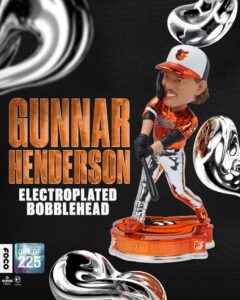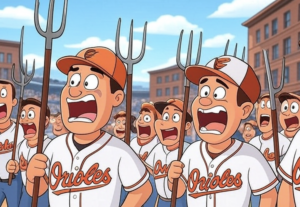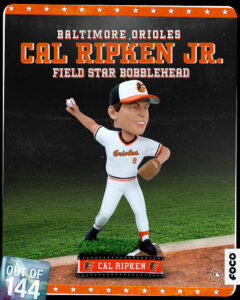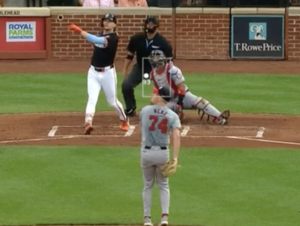If you’re a sabermetrics veteran, one who regularly tosses around fancy stats without effort, this isn’t the post for you. Click on back and go about your day perusing FanGraphs or Camden Depot or whatever it is you brainiacs do while trying to distill baseball for the rest of us (thanks for it all, by the way). This post is for SABR N000Bs. If you’re just dipping your foot in the SABR waters, I’m here to be a comforting hand to hold as we wade in together.
Check out our first lesson, on wOBA, here.
Listen, I love baseball card stats – tell me a hitter’s batting average, home runs, RBI, and stolen bases. Give me a pitcher’s ERA. Regale me with fielding percentage and number of errors. I’m not here to poo-poo any of those things, but what I’ve learned to do over the past several years is to open up my mind to other tools that very smart people have created and are now using to evaluate baseball players. While I resisted for years, once I overcame that resistance, a whole new world opened up. Things like FIP (Fielding Independent Pitching), O-Swing% (the percentage of times a batter swings at pitches outside of the strike zone), UZR (ultimate zone rating, a defensive metric, which SABR folks will even tell you they’re still working to refine) and more have only increased my enjoyment of our national pastime.
I’m not here to tell you that those old baseball card stats are wrong or that you should ignore them, by the way. Perhaps new tools aren’t your thing. Maybe you’re Harold Reynolds. Whatever. I’m just relaying my own experience, and saying that if you’re open minded to the fancy stats, I’ll be happy to count you as a peer as we all learn about this stuff together.
Since folks seemed to enjoy our first lesson (Bird’s Eye View was even kind enough to have me on their podcast to talk about it!), we’ll do another. Let’s try to get a little smarter today.
Topic 2: wRC and wRC+
After our first lesson, I got a very unexpected Tweet. The inventor of wOBA, Tom Tango, actually stumbled across my article somehow, and offered this little piece of advice:
Fancy Stats for Dummies – What the Heck is wOBA? https://t.co/RkhL9eAeU6 @BMoreBirdsNest If you want to compare to league average, use wRC+
— Tangotiger (@tangotiger) March 5, 2016
“If you want to compare to league average, use wRC+,” Tom suggested. Okay then!

But, he gave me way too much credit. First, I have to figure out what in the heck wRC+ is.
What I DO know is that that little “+” sign, when used in the world of #fancystats, doesn’t mean “plus” as in “wRC + O_LD _uP = World Cup,” but rather means that this stat has been normalized to the league average. That is, it’s easily comparable between players, like our old friend that we dismissed in our first lesson, OPS+.
As such, before we can understand what wRC+ is, we should probably work on what its non-weighted, non-normalized version, RC, is.
Nope, not the amazing Nintendo game R.C. Pro Am.
No, not Royal Crown cola either.
RC stands for Runs Created.
As always, the first step is our cathartic admission that “we are very late to the party on this and we should feel bad.” Everyone feel better now? Good, great, grand, wonderful…NO YELLING ON THE BUS!
So, as we did with wOBA, we’d like to start by looking at the formula.
In his The Bill James Historical Baseball Abstract, originally published in 1985, Bill James proposed the stat of RC, in which he tried to quantify the number of RUNS (all that really matters from an offensive player, right?) a batter creates based on all the offensive stats he puts up. His original formula was as follows:
Easy enough, right? (Hits + Walks) x Total Bases divided by (at-bats plus walks). Nothing too fancy or scary yet, for sure.
Of course, it didn’t stay nearly that simple. James realized that he needed to correct for things like base stealing ability, sacrifice flies, intentional walks, strikeouts, and more. Thus, the formula for RC evolved. When Mr. Tango developed his own statistic to quantify runs created, RC was replaced by wRC, Weighted Runs Created.
To do this, Tango used a metric he had already created – wOBA, remember – and simply modified it based on the league’s wOBA, the run environment that year, and similar factors.
As with the formula for wOBA, I implore you to not stare at it for too long. Again, we’re not calculating wRC values out on our own – we can just look them up. So, let’s do that. Here we have wRC leaders for the 2015 Baltimore Orioles:
When dealing with wRC, we need to remember that how “good” a player’s number is depends on the number of AB he had; that is, it’s cumulative (like HR or 2B), not presented in a per-AB basis (like batting average, slugging, or wOBA). So, J.J. Hardy having a wRC of 26 in 437 PA while Ryan Flaherty had the same number in 301 PA reminds us just how awful Hardy was last season.
Now that we’ve covered the building blocks, let’s get to the stat you’re much more likely to see cited when you read #fancystats articles about baseball: wRC+, or Weighted Runs Created Plus.
As FanGraphs tells us:
If you want a rate statistic for hitters that weights each offensive action and controls for league and park effects, wRC+ is for you. While wOBA is a huge step forward from stats like batting average and slugging percentage, it doesn’t credit hitters who play in difficult parks or deduct points for hitters who play in smaller ones. wRC+ brings all the virtues of wOBA plus two added benefits; park and league adjustments. A .400 wOBA at Coors is much less impressive than one at Petco, for example. Additionally, wOBA tracks with overall league offense, so you can’t use it to compare players of different eras very effectively. A .400 wOBA in 2000 is much less impressive than one in 2014, but a 140 wRC+ in 2000 means essentially the same thing in 2014.
How is wRC+ calculated? Well, if my advice was to not look at the wRC formula for too long, my tip when it comes to the wRC+ formula is not to look at it at all. Again, this is fancy stats for dummies. We’re not figuring these things out on our own, and those who are aren’t dummies.
Think of it like this: How much better (or worse) is a player at creating runs than the league average player? That’s wRC+. The average player comes in at 100. If player X’s wRC+ is 130, he’s 30% better than average; if it’s 75, he’s 25% worse than average. And it doesn’t matter if he’s mashing home runs in Camden Yards or watching the marine layer knock down everything he hits at AT&T Park, NOR does it matter if he’s taking his hacks during the dead-ball era, the steroid era, or today – these geniuses have figured out a way to factor all of that stuff in! Incredible.
(And that’s a big difference between wOBA and wRC+: the factoring in of park and league environment effects.)
And so, not only is wRC+ useful for looking at the 2015 Orioles leaders…
(Where we can see that Matt Wieters was perfectly average, Manny Machado was 34% better than the average hitter, and Hardy has completely disappeared from the Top 10 – his wRC+ of 49 was just barely above David Lough‘s of 47)
…but it’s also useful for looking at the best Orioles seasons of all time:
See any names on there you didn’t expect? I knew that we underappreciated Melvin Mora – especially his 2004 season – so I wasn’t too shocked to see him on there. Chris Hoiles though? That one jumped out at me for sure.
Alright, we know that wRC+ can quickly and easily give us an idea of how much better/worse a hitter is than average. But how much better than average does a guy have to be to be considered very good or great? FanGraphs gives us this handy little chart (with the caveat that it’s only an estimate):
Here’s to a bunch of Orioles posting 120 or higher wRC+ values this season, and to us now knowing what the hell that means!
Further Reading
wRC and wRAA (FanGraphs)
Intro to Sabermetrics – wRC+ (Baltimore Sports and Life)


















